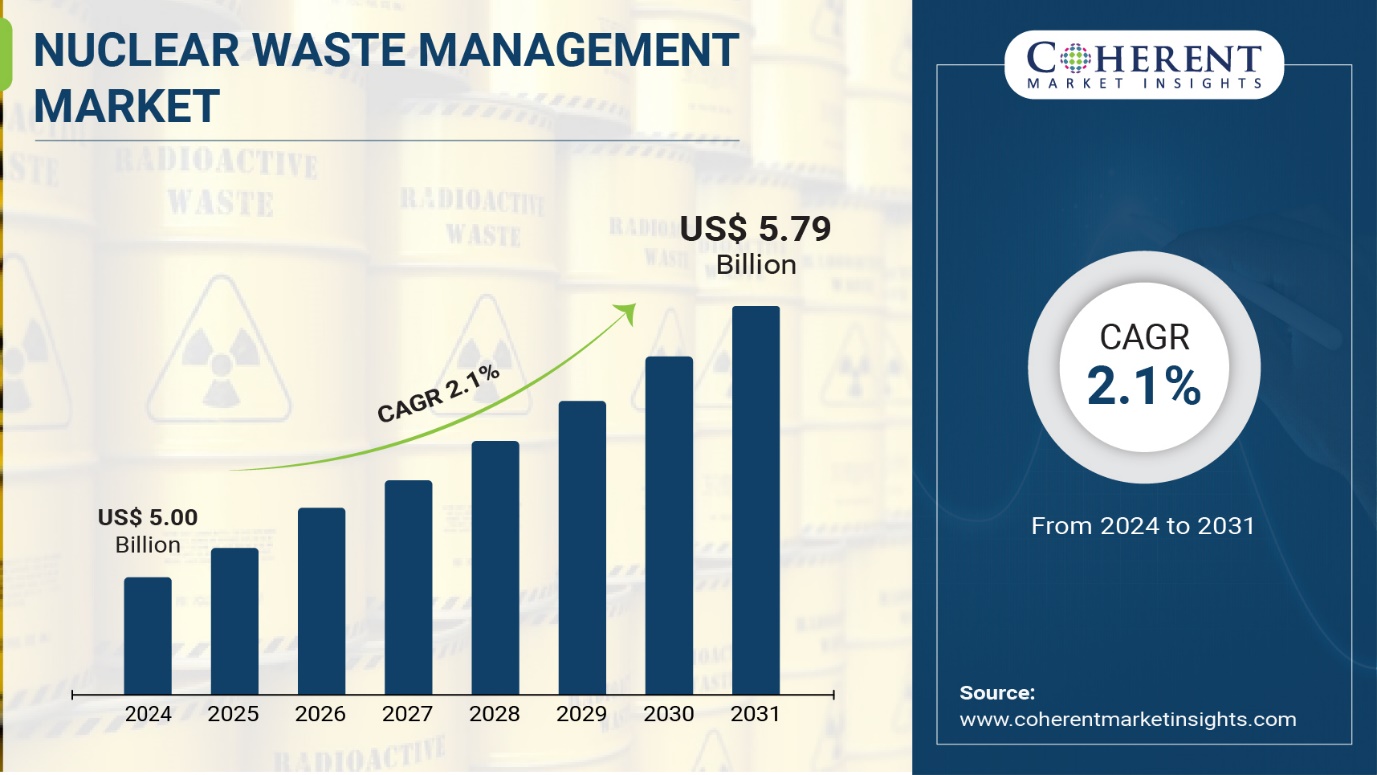Nuclear Waste Management Market to hit $5.79 billion, Globally, by 2031 at 2.1% CAGR, says Coherent Market Insights

Burlingame, Sept. 09, 2024 (GLOBE NEWSWIRE) -- The global Nuclear Waste Management Market is estimated to be valued at USD 5.00 Bn in 2024 and is expected to reach USD 5.79 Bn by 2031, exhibiting a compound annual growth rate (CAGR) of 2.1% from 2024 to 2031. as highlighted in a new report published by Coherent Market Insights. Growing adoption of reprocessing technologies to recover fissile materials from spent nuclear fuel is further fueling the market growth. Reprocessing not only helps in waste volume reduction but also supports sustainable utilization of nuclear resources.
Request Sample Report: https://www.coherentmarketinsights.com/insight/request-sample/7162

Market Dynamics:
The nuclear waste management market is primarily driven by the rising production of radioactive waste from nuclear power plants and increasing nuclear proliferation globally. About 250,000 metric tons of spent fuel is generated worldwide each year from nuclear power plants, and radioactive waste production is directly proportional to the operation of nuclear reactors. According to World Nuclear Association, there are around 450 operational nuclear power reactors globally which produce a significant amount of radioactive waste annually. Moreover, growing investment in research activities related to nuclear energy is also contributing to the market growth.
Nuclear Waste Management Market Report Coverage
| Report Coverage | Details |
| Market Revenue in 2023 | $5.00 billion |
| Estimated Value by 2031 | $5.79 billion |
| Growth Rate | Poised to grow at a CAGR of 2.1% |
| Historical Data | 2019–2023 |
| Forecast Period | 2024–2031 |
| Forecast Units | Value (USD Million/Billion) |
| Report Coverage | Revenue Forecast, Competitive Landscape, Growth Factors, and Trends |
| Segments Covered | By Waste Type, By Reactor Type, By Disposal Method |
| Geographies Covered | North America, Europe, Asia Pacific, and Rest of World |
| Growth Drivers | • Expanding nuclear power generation • Evolving regulations and standards |
| Restraints & Challenges | • High costs involved • Lack of permanent disposal facilities |
Market Trends:
One of the key trends observed in the nuclear waste management market is growing investment in reprocessing and recycling of spent nuclear fuel. Reprocessing spent fuel helps in recovering recyclable uranium and plutonium that can be used to manufacture fresh fuel. Countries such as France, Russia, India, and China have established large-scale facilities to reprocess nuclear waste. Another trend gaining traction is final geological disposal of high-level radioactive waste. Finland and Sweden have successfully developed underground repositories and have started disposing of canisters containing vitrified high-level nuclear waste.
Immediate Delivery Available | Buy This Premium Research Report: https://www.coherentmarketinsights.com/insight/buy-now/7162
Market Opportunities:
The global nuclear waste management market size was valued at USD 5.00 Bn in 2024 and is anticipated to witness a CAGR of 2.1% during the forecast period. With increasing nuclear power generation activities across the globe, the demand for proper nuclear waste storage and disposal is also on the rise.
Low-Level Waste (LLW) accounted for the largest share of over 60% in the global nuclear waste management market in 2024. LLW includes items that have become contaminated with radioactive material or have become radioactive through exposure to neutron radiation. Paper, rags, tools, clothing, filters, and other disposable materials which may contain small amounts of radioactive material are classified as LLW. Temporary storage of LLW is done either on-site or at centralized facilities until it has decayed to levels low enough to be disposed of in a landfill.
Intermediate-Level Waste (ILW) is expected to be the fastest growing segment during the forecast period. ILW contains higher levels of radioactivity than LLW but less than High-Level Waste. It requires shielding during handling and transport but not cooling. Examples include resins, chemical sludges, and metal reactor components which can be safely stored for shorter periods of time than high-level waste. Cementation, bituminization, and vitrification are the common techniques used to immobilize ILW for safe transportation and storage.
The storage of High-Level Waste (HLW) from used nuclear fuel is one of the most challenging aspects of the nuclear fuel cycle. HLW accounts for over 95% of the total radioactivity from used fuel. Pressurized Water Reactors generate bulk of HLW globally. Temporary storage of HLW is done in water-filled spent fuel pools or dry cask storage systems. Deep geological disposal involving multiple engineered and natural barriers is considered the safest option for the long-term isolation of HLW from the environment.
Key Market Takeaways
The global nuclear waste management market is anticipated to witness a CAGR of 2.1% during the forecast period 2024-2031, owing to increasing nuclear energy production worldwide.
On the basis of waste type, low-level waste segment is expected to hold a dominant position, accounting for over 60% of the market share owing to ease of handling and disposal of LLW.
On the basis of reactor type, pressurized water reactors dominate the nuclear industry globally and produce bulk of nuclear waste.
Regionally, North America is expected to hold the largest market share over the forecast period, due to large number of operating nuclear power plants in the US.
Key players operating in the nuclear waste management market include Enercon, Veolia, US Ecology Inc. Spend fuel reprocessing is expected to gain more prominence in the coming years to reduce the burden of high-level waste disposal.
Request For Customization: https://www.coherentmarketinsights.com/insight/request-customization/7162
Recent Developments:
In December 2018, Magnox Ltd has given Wood a significant contract for the removal, processing, and disposal of radioactive waste from a decommissioned nuclear power plant in the UK. 47m3 of radioactive wet waste that has been kept in tanks at Dungeness A in Kent will be removed as part of the project.
In November 2022, the Biden administration had planned for raising the funding in projects to recycle nuclear waste from power plants including through reprocessing, a technology that has not been practiced in the United States for decades because of concerns about costs and proliferation.
Detailed Segmentation-
By Waste Type:
- Low-Level Radioactive Waste
- Intermediate-Level Radioactive Waste
- High-Level Radioactive Waste
By Reactor Type:
- Pressurized Water Reactor
- Boiling Water Reactor
- Gas Cooled Reactor
- Pressurized Heavy Water Reactor
By Disposal Method:
- Incineration
- Storage
- Deep Geological Disposal
- Others
By Region:
North America:
Latin America:
- Brazil
- Argentina
- Mexico
- Rest of Latin America
Europe:
- Germany
- U.K.
- Spain
- France
- Italy
- Russia
- Rest of Europe
Asia Pacific:
- China
- India
- Japan
- Australia
- South Korea
- ASEAN
- Rest of Asia Pacific
Middle East:
- GCC Countries
- Israel
- Rest of Middle East
Africa:
- South Africa
- North Africa
- Central Africa
Have a Look at Trending Research Reports on Energy Domain:
Power Grid System Market: The Global Power Grid System Market is estimated to be valued at USD 11.67 Bn in 2024 and is expected to reach USD 24.78 Bn by 2031, exhibiting a compound annual growth rate (CAGR) of 11.4% from 2024 to 2031.
Renewable Natural Gas Market: The global renewable natural gas market is estimated to be valued at USD 14.03 Bn in 2024 and is expected to reach USD 24.23 Bn by 2031, exhibiting a compound annual growth rate (CAGR) of 12.1% from 2024 to 2031.
Nuclear Fusion Market: The Nuclear Fusion Market is estimated to be valued at USD 331.26 Bn in 2024 and is expected to reach USD 491.55 Bn by 2031, exhibiting a compound annual growth rate (CAGR) of 5.8% from 2024 to 2031.
Wave Energy Converter Market: The wave energy converter Market size is valued US$ 19.52 Bn in 2024 and is expected to reach US$ 26.15 Bn by 2031, growing at a compound annual growth rate (CAGR) of 4.3% from 2024 to 2031.
Author Bio:
Ravina Pandya, PR Writer, has a strong foothold in the market research industry. She specializes in writing well-researched articles from different industries, including food and beverages, information and technology, healthcare, chemical and materials, etc. With an MBA in E-commerce, she has an expertise in SEO-optimized content that resonates with industry professionals.
About Us:
Coherent Market Insights is a global market intelligence and consulting organization that provides syndicated research reports, customized research reports, and consulting services. We are known for our actionable insights and authentic reports in various domains including aerospace and defense, agriculture, food and beverages, automotive, chemicals and materials, and virtually all domains and an exhaustive list of sub-domains under the sun. We create value for clients through our highly reliable and accurate reports. We are also committed in playing a leading role in offering insights in various sectors post-COVID-19 and continue to deliver measurable, sustainable results for our clients.

Mr. Shah Senior Client Partner – Business Development Coherent Market Insights Phone: US: +1-650-918-5898 UK: +44-020-8133-4027 AUS: +61-2-4786-0457 India: +91-848-285-0837 Email: sales@coherentmarketinsights.com Website: https://www.coherentmarketinsights.com
© 2024 Benzinga.com. Benzinga does not provide investment advice. All rights reserved.
Breaking news
See all17 hours ago








